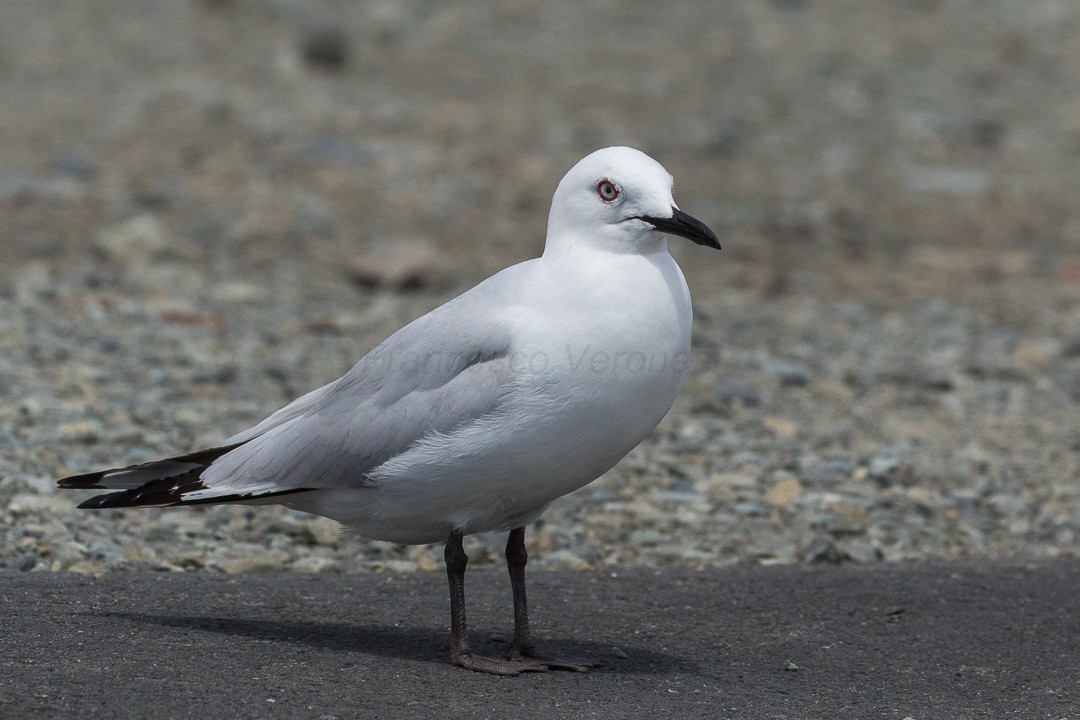Black-billed Gull
A species of Masked Gulls Scientific name : Chroicocephalus bulleri Genus : Masked Gulls
Black-billed Gull, A species of Masked Gulls
Botanical name: Chroicocephalus bulleri
Genus: Masked Gulls
Content
Description People often ask General Info
 Photo By Francesco Veronesi , used under CC-BY-SA-2.0 /Cropped and compressed from original
Photo By Francesco Veronesi , used under CC-BY-SA-2.0 /Cropped and compressed from original Description
A healthy adult black-billed gull is typically 35–38 cm long, with a wingspan of 81–96 cm, and a weight of around 230g. The head, body, and parts of the wings are white, with silvery grey on the saddle and wings, as well as black edging on the wings. The gull also undergoes some seasonal color change. While typically black from February to June, the orbital ring is orange-red, red, or dark red the rest of the year. The legs, too, change from black to dark red and even bright red as the breeding season progresses, "possibly stimulated by presence of begging chicks and juveniles." Observations suggest the gull is sexually dimorphic, but there is a lack of published data to support this. There is likewise a lack of data in regard to geographical variation. Easily mistaken for the red-billed gull, the black-billed gull is distinguished by its black bill and is described as having a “more delicate appearance,” a “more buoyant and graceful” flight, and being “generally less noisy,” despite having a similar call. F1 and F2 hybrids between the two gulls have been observed, both hybrids exhibiting dark red bills. 
Size
38 cm
Life Expectancy
30 years
Nest Placement
Ground
Feeding Habits
Black-billed Gull primarily consumes earthworms, insects, small fish, and aquatic invertebrates, including waste at times. They forage in flocks in various environments like ploughed fields and pastures. Adapted to both land and air feeding, they employ group foraging strategies and exhibit surface-dipping and hawking behaviors.
Habitat
Black-billed Gull favor estuarine and coastal zones, along with inland braided river systems essential for breeding. Their adaptive nature allows them to thrive in diverse settings, such as lakes, urban parks, wet grasslands, and agricultural landscapes. Although predominantly found in southern regions, they exhibit seasonal migrations and adaptability across varied altitudes, from sea level to mountainous terrains.
Dite type
Piscivorous
People often ask
General Info
Feeding Habits
Bird food type
Behavior
Colonies are formed around the first pair that begins nesting. Where more than one pair forms the initial nest, clustering around these sites takes place within the colony. Colonies are frequently tightly packed, with “Gulls little more than pecking distance from each other and nests often touch, leaving little room for taking off and landing.” Males may display aggressive behavior towards others in an “ill-defined area” for a few minutes before leaving the area and forgetting it. Nonetheless, not all male aggression is linked to defending a particular area, and some pairs without chicks will show aggression towards those with chicks. Fights are rarely prolonged, usually consisting of a single attack by the aggressor, employing the bill for pecking, the wings for beating, and the legs for scratching. The target typically retreats right away. Adults roost at the breeding colony or feeding sites, though the latter is more common. 
Distribution Area
The black-billed gull is endemic to New Zealand. Up to 78% of the total population is estimated to be living in the Southland region, on the southern end of the South Island. In breeding season the gull is found on major rivers, especially braided rivers, lakes, and farmland. It generally prefers estuaries and coastal areas outside of the breeding season, though some can be found at breeding sites all year round. The gull is also attracted to urban areas, and "anywhere refuse of scraps available", such as rubbish dumps and freezing works. In 2019 some gulls established a colony of around 300 birds in Christchurch Central City. The species has been sighted occasionally on Stewart Island and The Snares, as well as at altitudes of up to 1700 MASL on the mainland. Various colonies also live on the North Island, though it was formerly only a "visitor," the first recorded breeding taking place at Lake Rotorua in 1932. Some South Island birds cross the Cook Strait after breeding season to winter in the North Island. 
Species Status
In October 2018, the Department of Conservation began a trial cull of black-backed gulls along the Hurunui River to control predation of black-billed gull chicks and other threatened bird species. In August 2019, after a successful trial, the Department announced a five-year programme extending to the Waiau Uwha River that aims to reduce the black-backed gull population in the areas by at least eighty per cent. The black-billed gull placed 30th, with 441 votes, in Forest & Bird's 2018 Bird of the Year competition. 
Scientific Classification
Phylum
Chordates Class
Birds Order
Shorebirds Family
Gulls Genus
Masked Gulls Species
Black-billed Gull